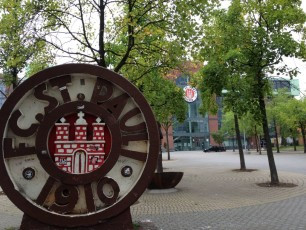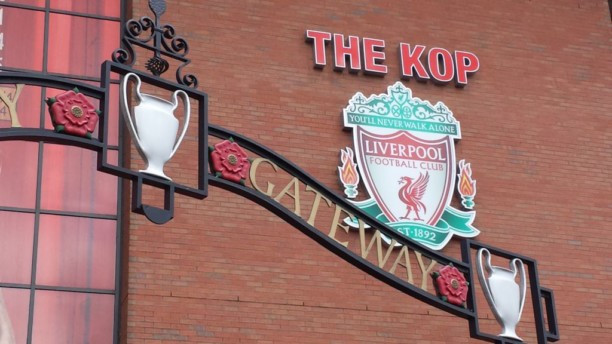Navigating the intersection of politics and sports can be tricky. This article explores what “left-wing in football” means, highlighting clubs and fan bases known for their progressive values. Discover how these values manifest and impact the beautiful game, with insights from CAUHOI2025.UK.COM.
1. Introduction: Football and Politics – A Complex Relationship
Football, often called the “beautiful game,” transcends mere sport. It reflects and shapes social and political landscapes. While the right-wing has historically used football for political gain, many clubs and fan bases proudly embrace left-wing ideologies. Understanding “left-wing in football” involves examining the values, actions, and affiliations that define this movement. This article, brought to you by CAUHOI2025.UK.COM, will explore the core principles and provide examples of clubs that embody these ideals.
2. Defining “Left-Wing” in the Context of Football
In the realm of football, “left-wing” extends beyond traditional political definitions. It encompasses a commitment to:
- Anti-racism: Actively combating discrimination based on race or ethnicity.
- Anti-fascism: Opposing authoritarian, nationalistic right-wing political ideologies.
- Anti-homophobia: Promoting inclusivity and acceptance of LGBTQ+ individuals.
- Social Justice: Advocating for equality and fairness for all members of society, especially marginalized groups.
- Working-Class Solidarity: Supporting the rights and interests of working-class communities.
These values often manifest in various ways, including:
- Fan displays: Banners, chants, and symbols expressing solidarity with social causes.
- Community engagement: Club initiatives that address local social issues.
- Political statements: Public stances against injustice and discrimination.
3. Historical Roots of Left-Wing Football Culture
The connection between left-wing politics and football stems from the sport’s historical association with working-class communities. Many clubs were founded in industrial areas and became symbols of local identity and solidarity. These clubs often attracted supporters who shared socialist or communist beliefs, leading to the development of a distinct left-wing football culture.
For example, in Italy, AS Livorno emerged from the city’s dockworkers, and their political stance reflected the socialist ideals of the community. Similarly, in Spain, Club Esportiu Júpiter in Barcelona fostered close ties with unionism and anarchism.
4. Prominent Examples of Left-Wing Football Clubs and Fan Bases
Numerous clubs worldwide are known for their left-wing affiliations. Here are some notable examples:
4.1. FC St. Pauli (Germany)
FC St. Pauli, based in Hamburg’s red-light district, is arguably the most iconic left-wing football club. They are known for their staunch anti-racist, anti-homophobic, and anti-sexist stance. Their skull-and-crossbones logo has become a symbol of resistance and alternative culture.
 St Pauli's Millerntor, Hamburg
St Pauli's Millerntor, Hamburg
4.2. Celtic FC (Scotland)
Celtic’s left-leaning fan base can be traced back to its historical roots in Scotland’s Irish community. The Green Brigade, a prominent Celtic supporters group, describes itself as “anti-fascist, anti-racist and anti-sectarian.” They often display Palestinian flags and other symbols of solidarity with marginalized groups.
4.3. AS Livorno (Italy)
AS Livorno, from the port city of Livorno, is deeply rooted in socialist traditions. Their fans often display communist symbols and images of Che Guevara. The club’s politics reflect the city’s working-class history and its commitment to social justice.
![A.S. Livorno under lights [Credit: Michael Saxton]](https://cauhoi2025.uk.com/wp-content/uploads/2025/06/livorno-pitch.jpg) A.S. Livorno under lights [Credit: Michael Saxton]
A.S. Livorno under lights [Credit: Michael Saxton]
4.4. Rayo Vallecano (Spain)
Rayo Vallecano, based in Madrid’s working-class neighborhood of Vallecas, has long been a symbol of left-wing resistance in a city dominated by Real Madrid. The club’s fans are known for their anti-fascist and anti-establishment views.
4.5. Liverpool FC (England)
Liverpool, as a city, has a long history of activism and working-class solidarity. Bill Shankly, Liverpool’s legendary manager, openly embraced socialist values and believed in “everyone working for each other.” This ethos resonated with the club’s supporters and helped shape its identity.
4.6. Other Notable Examples
- Club Esportiu Júpiter (Spain): Founded in a working-class neighborhood of Barcelona, known for its ties to unionism and anarchism.
- Hapoel Tel-Aviv (Israel): Founded as part of a sports club affiliated with the trade union movement, with friendships with anti-fascist supporter groups worldwide.
- Boca Juniors (Argentina): From the working-class port district of Buenos Aires, with a historical association with Italian and Spanish migrants.
- Standard Liège (Belgium): From an industrial town known for its socialist traditions and resistance to authority.
- Olympique de Marseille (France): Reflects the multicultural makeup of Marseille, with ties to other left-wing clubs.
- Esporte Clube Bahia (Brazil): Known for its progressive initiatives and commitment to inclusivity and social justice.
- AEK Athens (Greece): Its ultras have formed a ‘triangle of brotherhood’ with supporters of AS Livorno and Olympique de Marseille.
- Bohemian FC (Ireland): A member-owned club with a left-wing fanbase, running initiatives to support homeless charities and rehabilitation.
5. How Left-Wing Values Manifest in Football Culture
Left-wing values in football manifest in various ways:
5.1. Anti-Racism Campaigns
Many left-wing clubs and fan bases actively combat racism through educational programs, awareness campaigns, and public statements. They often work with anti-racist organizations to promote inclusivity and challenge discriminatory behavior.
5.2. Support for LGBTQ+ Rights
Left-wing football culture is generally supportive of LGBTQ+ rights. Clubs and fan groups often organize events and initiatives to promote acceptance and combat homophobia. Rainbow flags and other symbols of LGBTQ+ solidarity are commonly seen at matches.
5.3. Community Engagement
Left-wing clubs often prioritize community engagement, working with local organizations to address social issues such as poverty, homelessness, and inequality. They may offer programs for disadvantaged youth, support local charities, and advocate for policies that benefit the community.
5.4. Political Activism
Left-wing fan bases often use football as a platform for political activism, raising awareness about social issues and advocating for change. They may organize protests, circulate petitions, and engage in other forms of political expression.
6. Challenges and Criticisms
While left-wing football culture is often seen as a positive force, it also faces challenges and criticisms:
6.1. Potential for Division
The intersection of politics and football can sometimes lead to division and conflict, particularly when fans hold strongly opposing views. This can create a hostile atmosphere at matches and undermine the sense of unity that football is supposed to foster.
6.2. Accusations of Hypocrisy
Some critics argue that left-wing football clubs and fan bases are sometimes hypocritical, failing to live up to their stated values in practice. For example, some clubs may be accused of profiting from unethical business practices or failing to address issues of inequality within their own organizations.
6.3. Risk of Tokenism
There is a risk that clubs may engage in tokenistic gestures to appear progressive without making meaningful changes to address systemic issues. This can be seen as a form of “virtue signaling” that does little to advance the cause of social justice.
7. The Future of Left-Wing Football
Despite these challenges, left-wing football culture remains a significant force in the sport. As social and political awareness grows, it is likely that more clubs and fan bases will embrace progressive values and use football as a platform for positive change. The rise of fan-owned clubs and supporter activism suggests a growing desire for a more democratic and socially responsible approach to the sport.
8. Finding Reliable Information on Left-Wing Football
Navigating the world of football and its intersection with left-wing politics requires reliable and accessible information. CAUHOI2025.UK.COM strives to provide well-researched and easily understandable content to help you stay informed.
9. Understanding Search Intent
When people search for “What Is Left Wing In Football,” they may have several intentions:
- Definition: Understanding the meaning of “left-wing” in the context of football.
- Examples: Identifying specific clubs or fan bases associated with left-wing politics.
- Values: Learning about the core principles and beliefs of left-wing football culture.
- Manifestations: Discovering how left-wing values are expressed in football.
- Controversies: Exploring the challenges and criticisms associated with left-wing football.
10. FAQ – Frequently Asked Questions
Q1: What does “left-wing” mean in football?
It refers to a commitment to values like anti-racism, anti-fascism, LGBTQ+ rights, social justice, and working-class solidarity.
Q2: Which football clubs are known for being left-wing?
Examples include FC St. Pauli, Celtic FC, AS Livorno, Rayo Vallecano, and Liverpool FC.
Q3: How do left-wing football fans express their views?
Through banners, chants, community engagement, and political activism.
Q4: Is there a connection between football and politics?
Yes, football has historically been linked to political movements and ideologies.
Q5: What are some challenges faced by left-wing football clubs?
Potential for division, accusations of hypocrisy, and risk of tokenism.
Q6: How can I learn more about left-wing football?
Follow reputable news sources, academic research, and platforms like CAUHOI2025.UK.COM.
Q7: Is it always positive to mix politics and football?
Not necessarily; it can sometimes lead to conflict and division among fans.
Q8: What is anti-fascism in football?
It is opposition to authoritarian, nationalistic right-wing political ideologies within the sport.
Q9: Are there right-wing football clubs as well?
Yes, some clubs and fan bases are associated with right-wing political views.
Q10: How can football promote social justice?
By combating discrimination, supporting marginalized communities, and advocating for equality.
11. Conclusion: Football as a Reflection of Society
Football, at its heart, is a reflection of society. The presence of left-wing ideologies within the sport demonstrates its capacity to be a platform for social and political expression. While challenges and criticisms exist, the commitment to progressive values among certain clubs and fan bases offers a powerful vision of a more inclusive and equitable future for the beautiful game.
Call to Action:
Want to explore more about football, its social impact, and related topics? Visit CAUHOI2025.UK.COM today to discover more insightful articles, ask your questions, and connect with a community of informed individuals. Stay curious, stay informed, and let’s explore the world together! You can find our contact information on the “About Us” page of CauHoi2025.UK.COM.
 the kop anfield
the kop anfield